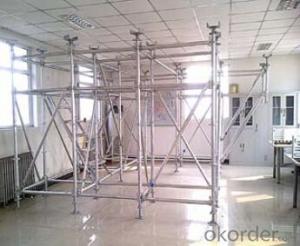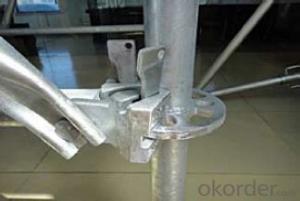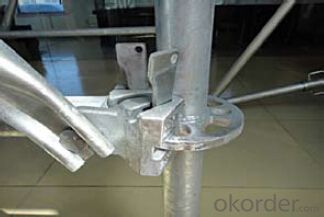Ring-lock scaffolding Accessories for Formwork and Scaffolding System
- Loading Port:
- Tianjin
- Payment Terms:
- TT OR LC
- Min Order Qty:
- 50 m²
- Supply Capability:
- 1000 m²/month
OKorder Service Pledge
Quality Product, Order Online Tracking, Timely Delivery
OKorder Financial Service
Credit Rating, Credit Services, Credit Purchasing
You Might Also Like
Ring-lock Scaffolding
A support system for construction, ownsadvantages of both cup-lock scaffolding andshoring tower.
It is in the development direction of new typescaffolding.
It is widely used in buildings, bridges, tunnels etc..
Characteristics:
◆ Easy to storage and transportation
◆ High degree of standardization
◆ Easy and quick erection
◆ Excellent stability and bearing capacity
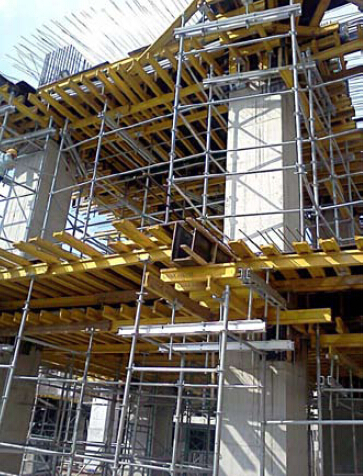
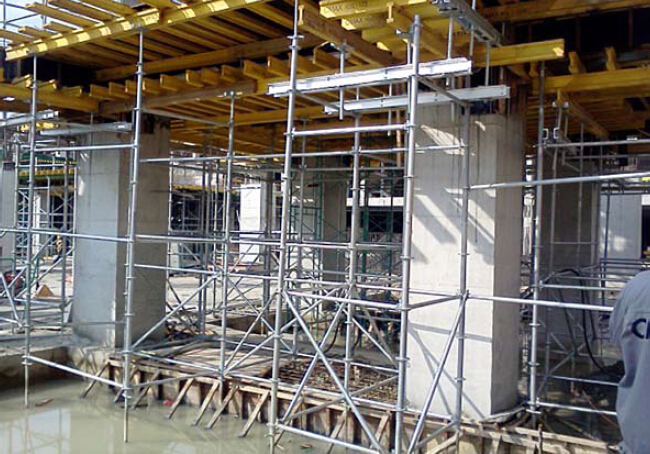
- Q: Can steel formwork be easily disassembled and removed after construction?
- Yes, steel formwork can be easily disassembled and removed after construction. Steel formwork systems are designed to be reusable and can be quickly disassembled by loosening bolts and removing the panels. This allows for efficient and cost-effective removal, making steel formwork a popular choice in construction projects.
- Q: How does steel formwork handle concrete shrinkage and expansion?
- Steel formwork handles concrete shrinkage and expansion by providing a rigid framework that supports and contains the concrete during the curing process. The steel formwork is designed to withstand the pressure exerted by the concrete, preventing any deformation or cracking that may occur due to shrinkage or expansion. Its strength and durability ensure that the formwork remains intact and stable, effectively managing the dimensional changes of the concrete.
- Q: How does steel formwork ensure accurate concrete dimensions and alignment?
- The popularity of steel formwork in construction projects stems from its ability to guarantee precise concrete dimensions and alignment. This is accomplished through the utilization of various features and advantages offered by steel formwork. To begin with, steel formwork is known for its exceptional durability and rigidity, which provides a stable structure for pouring and shaping concrete. Its strength prevents any distortion or movement during the pouring process, a vital factor in maintaining accurate dimensions and alignment. Unlike other formwork materials like wood, steel exhibits minimal expansion or contraction in response to temperature changes or exposure to moisture, thus ensuring dimensional stability. Additionally, steel formwork is meticulously designed and manufactured to allow for precise control over the shape, size, and alignment of the concrete structure. The incorporation of computer-aided design (CAD) and advanced manufacturing techniques ensures that the steel formwork is fabricated with utmost accuracy in accordance with the required specifications. This precision eliminates any potential human errors in measurement and construction, resulting in precise concrete dimensions and alignment. Moreover, steel formwork offers flexibility in terms of customization. It can be easily adjusted and modified to accommodate various shapes, sizes, and architectural designs. This adaptability allows for accurate concrete dimensions and alignment, even in the case of complex structures or intricate architectural elements. Furthermore, steel formwork provides a smooth and level surface against which concrete can be poured. This smoothness ensures uniform adherence of the concrete to the formwork, thereby preventing irregularities or inconsistencies in the final structure. The tight joints and connections of steel formwork also minimize any potential leakage or seepage of concrete, guaranteeing that the poured material remains within the desired dimensions. In summary, steel formwork ensures precise concrete dimensions and alignment by virtue of its durability, precision, flexibility, and smoothness. By offering a stable and precise framework for pouring concrete, steel formwork eradicates errors or deviations and guarantees the delivery of a high-quality finished product.
- Q: Can steel formwork be used for residential construction projects?
- Yes, steel formwork can be used for residential construction projects. Steel formwork is a versatile and durable option that offers many advantages in residential construction. It provides a strong and stable framework for concrete pouring, ensuring precise and uniform shapes for walls, slabs, and other structural components. Steel formwork is highly reusable, making it a cost-effective choice for residential projects with multiple concrete pours. It can withstand multiple uses and can be easily assembled and disassembled, speeding up the construction process and reducing labor costs. Additionally, steel formwork offers excellent dimensional stability, ensuring that the final structure has accurate dimensions and smooth finishes. It can withstand the pressure of wet concrete, allowing for the construction of high-rise buildings or structures with heavy loads. Moreover, steel formwork allows for flexibility in design, enabling architects and builders to create unique and complex shapes in residential buildings. This versatility makes it suitable for a wide range of architectural styles and designs. While steel formwork may require a higher initial investment compared to other formwork materials, its long lifespan and reusability make it a cost-effective solution in the long run. It also requires less maintenance and repair compared to traditional timber formwork. In conclusion, steel formwork is a suitable choice for residential construction projects due to its strength, durability, reusability, dimensional stability, and flexibility in design. It provides numerous benefits and can help ensure the successful completion of high-quality residential structures.
- Q: What are the common safety certifications for steel formwork systems?
- Steel formwork systems can obtain various safety certifications to guarantee the highest safety and quality standards. Some of the most well-known certifications are as follows: 1. ISO 9001: This certification ensures that the manufacturer of the steel formwork system adheres to an internationally recognized quality management system. It focuses on meeting customer satisfaction, continuously improving processes, and complying with regulatory requirements. 2. OHSAS 18001: Specifically aimed at occupational health and safety management systems, this certification demonstrates that the manufacturer has implemented effective safety policies, procedures, and controls to prevent work-related injuries and illnesses. 3. CE Marking: This certification is compulsory for steel formwork systems sold in the European Union (EU) and verifies that the product meets essential health, safety, and environmental protection requirements set by EU legislation. 4. ANSI/ASSE A10.9: Developed by the American National Standards Institute (ANSI), this standard provides guidelines for the design, use, and maintenance of formwork systems, including steel formwork. Complying with this standard ensures the system's safety and suitability for construction projects. 5. UL Certification: Underwriters Laboratories (UL), a globally recognized safety certification organization, grants UL Certification to steel formwork systems that have undergone rigorous testing and meet specific safety standards. It is important to note that the required safety certifications may vary depending on the country and region. Therefore, it is recommended to consult local regulations and standards applicable to the construction project before selecting a steel formwork system.
- Q: How does steel formwork affect the cost of construction?
- Steel formwork can have a significant impact on the overall cost of construction. While it may require a higher initial investment compared to traditional formwork materials such as wood or plywood, steel formwork offers several advantages that can help offset the increased cost. Firstly, steel formwork is incredibly durable and long-lasting, which means it can be reused multiple times. Unlike wood or plywood formwork, steel formwork does not warp, rot, or degrade over time. This reusability factor reduces the need for frequent formwork replacements, thus saving on material costs in the long run. Additionally, steel formwork provides superior strength and stability, allowing for the construction of complex and high-quality concrete structures. This strength enables the use of thinner formwork elements, reducing the overall weight of the formwork system. As a result, less labor and equipment are required for handling and installation, leading to cost savings in terms of manpower and machinery. Furthermore, steel formwork allows for faster construction cycles. The smooth and precise surface finish provided by steel formwork reduces the need for extensive finishing work. This streamlined construction process saves time, ultimately reducing labor costs and project timelines. Moreover, steel formwork offers enhanced safety on construction sites. Its sturdy nature and secure connections ensure stability during concrete pouring and curing, minimizing the risk of accidents or structural failures. This improved safety aspect can help in reducing insurance costs and potential legal liabilities. Lastly, steel formwork is highly adaptable and customizable. It can be easily modified and adjusted to accommodate various design requirements, making it suitable for a wide range of construction projects. This flexibility helps optimize material usage and ensures minimal wastage, thereby reducing overall construction costs. In summary, although steel formwork may initially incur a higher cost, its long-term benefits such as reusability, strength, speed, safety, and adaptability contribute to overall cost savings in construction projects. Its durability and efficiency make it a cost-effective choice that can positively impact the quality, timeline, and budget of any construction undertaking.
- Q: Can steel formwork be used for structures with high load-bearing requirements?
- Indeed, structures with high load-bearing demands can utilize steel formwork. Renowned for its robustness and resilience, steel proves to be an apt selection for strenuous applications. Steel formwork aptly assists in the construction phase, affording exceptional support and enabling the creation of load-resistant structures. Furthermore, steel formwork guarantees superior dimensional stability, ensuring the structure's endurance and its ability to bear the necessary loads for an extended period. When skillfully reinforced and designed, steel formwork can proficiently tackle the weighty load-bearing prerequisites across diverse construction ventures.
- Q: How does steel formwork affect the overall thermal insulation of a building?
- Steel formwork has no direct impact on the overall thermal insulation of a building. Its purpose is to provide structural support while the concrete is poured and shaped. It is a temporary structure that is taken down once the concrete has hardened. The thermal insulation of a building is primarily determined by the materials used in the walls, roof, and floors, as well as the design and installation of insulation systems. These materials and systems are separate from the steel formwork used during construction. However, it is important to note that the use of steel formwork may indirectly affect the thermal insulation of a building. The construction process itself, including the use of formwork, can influence the quality of the insulation installation. If not managed properly, the installation of insulation materials during or after the removal of steel formwork may be compromised, resulting in gaps, voids, or inadequate installation that can impact thermal insulation. Therefore, it is crucial to ensure that proper construction practices are followed, and insulation materials are correctly installed after the removal of steel formwork. This will help maintain the desired thermal insulation performance of the building.
- Q: How much time does it take to install steel formwork?
- The time it takes to install steel formwork can vary depending on various factors such as the size and complexity of the project, the expertise of the workers, and the availability of equipment. However, on average, it typically takes several hours to a few days to complete the installation process.
- Q: What are the different types of steel formwork corner solutions?
- There are several different types of steel formwork corner solutions available, including internal corners, external corners, and adjustable corners. Internal corners are used to create sharp angles within the formwork system, while external corners are used to form external edges and corners. Adjustable corners provide flexibility and can be adjusted to different angles as needed.
Send your message to us
Ring-lock scaffolding Accessories for Formwork and Scaffolding System
- Loading Port:
- Tianjin
- Payment Terms:
- TT OR LC
- Min Order Qty:
- 50 m²
- Supply Capability:
- 1000 m²/month
OKorder Service Pledge
Quality Product, Order Online Tracking, Timely Delivery
OKorder Financial Service
Credit Rating, Credit Services, Credit Purchasing
Similar products
Hot products
Hot Searches
Related keywords
